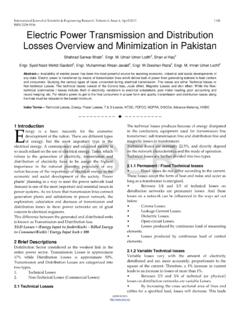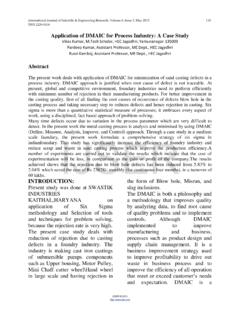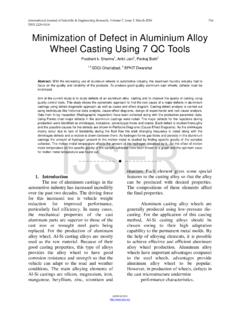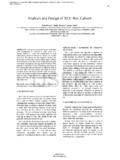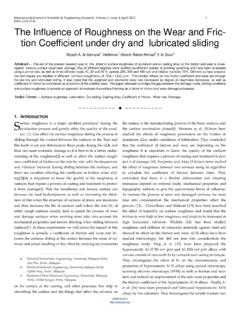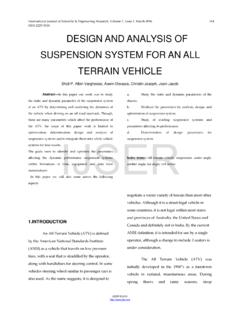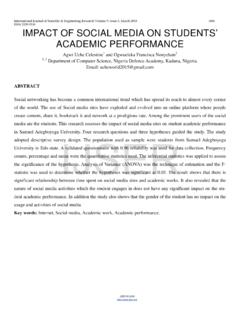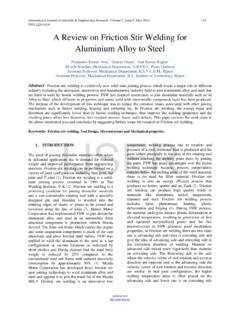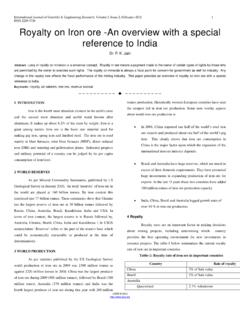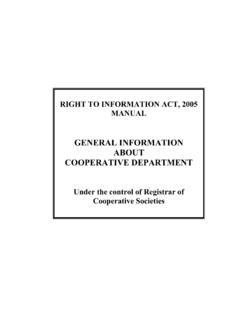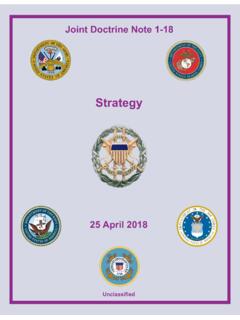Transcription of A Case Study of Amul Cooperative in India in Relation to ...
1 International Journal of Scientific & Engineering Research Volume 4, Issue 1, January-2013 1 ISSN 2229-5518 IJSER 2013 A CASE Study OF AMUL CO- operative IN India IN Relation TO ORGANIZATIONAL DESIGN AND OPERATIONAL EFFICIENCY FIRST AUTHOR Dr. Ruchira Prasad Lecturer in Management Seth Padam Chand Jain Institute of Management Agra University, Khandari, Agra Utter Pradesh, India Email: SECOND AUTHOUR Dr. Rupali Satsangi Assistant Professor Department of Economics DEI. Dayalbagh Educational Institute Dayalbagh, Agra-2822005 Utter Pradesh, India Email: International Journal of Scientific & Engineering Research Volume 4, Issue 1, January-2013 2 ISSN 2229-5518 IJSER 2013 A CASE Study OF AMUL CO- operative IN India IN Relation TO ORGANIZATIONAL DESIGN AND OPERATIONAL EFFICIENCY Dr.
2 Ruchira Prasad and Dr. Rupali Satsangi ABSTRACT Organizational Structure can improve the working condition of an organization and a poor structure can ruin all the possibilities of openness, dynamism and decision-making. Organizational effectiveness on the other hand, is the extent to which an organization, given certain resources and means, achieves its objectives without placing undue strain on its members. Another important role is played by the technology. More an organization is able to adapt itself to the changing technology the better will be its efficiencies. In the present research paper a relationship between the designs of an organization with its operational efficiency indicators has been examined in the context of The factors were studied in context to a Cooperative form of organization and while comparing with the corporate form, it was found that the design of the basic structure is somewhat different as it believes in the federal form of structure each unit is independent of each other.
3 It is a popular belief that co-operatives are a failure, but Amul with Co- operative Structure is a grand success. Amul has an appropriate blend of policy makers, technology and a support system to the milk producers without disturbing their agro-economic system and ploughing back the profits, by prudent use of men, materials and machines. Keywords: Organizational Structure, dynamism, Organizational effectiveness, operational efficiency, federal, agro-economic system. INTRODUCTION An organization is a social unit or a group of people structured in such a way that they work for achievement of specific goal. Structure can improve the working condition of an organization and a poor structure can ruin all the possibilities of openness, dynamism and decision making. Organizational effectiveness is the extent to which an organization, given certain resources and means, achieves its objectives without placing undue strain on its members.
4 Another important role is played by communication among the employees and the technology. More an organization is able to adapt itself to the changing technology the better will be its efficiencies. Amul s structure was founded on the basis of Cooperative system. SIGNIFICANCE OF THE Study In the present research paper a relationship between the designs of an organization with its operational efficiency indicators has been examined. It was found that these indicators play a very important role in the success of the organization. The factors were studied in the context to a co- operative form of organization and while comparing it with the corporate form, it was found that the design of the Amul structure is somewhat different as it believes in the federal form of structure each unit is independent of each other. OBJECTIVE OF THE Study To make Study more scientific and systematic the researcher frame following objectives: 1) To Study the significance of Amul co- operative in India .
5 2) To identify the relationship between organizational design and operational efficiency of Amul co- operative in India . 3) To suggest an action plan for smooth functioning of Amul co- operative in India . RESEARCH METHODOLOGY To evaluate the success of Organizational Design the two types of data sources are considered. Primary Source as well as Secondary Source. Primary data was collected through a structured closed / open-ended questionnaire and interviews with senior officials of AMUL, its employees and customers. Research Design Table Secondary data was collected trough internet, news papers, magazines, journals and annual reports. ORGANIZATIONAL DESIGN Geographical Area of the research Anand in Kaira district of Gujrat Sample population Kaira district milk producer s union Ltd Type of Sample Convenient sampling Respondents Employees of different hierarchal level of the AMUL and the producer members.
6 Size of sample 200 (100 farmers and 100 employees of different hierarchal level of AMUL) Type of research Analytical International Journal of Scientific & Engineering Research Volume 4, Issue 1, January-2013 3 ISSN 2229-5518 IJSER 2013 Organizational design is a formal, guided process for integrating the people, form of the organization as closely as possible to the purpose of an organization. It is used to match the organization seek to achieve. Through the design process, organizations act to improve the probability that the collective efforts of members will be successful. Organizational design involves the creation of roles, processes and formal reporting relationships in an organization. THE AMUL MODEL Amul has a Co- operative form with a blend of professionalism.
7 In the corporate form of an organization the shareholders are non-participative members whereas in this form the members are the participative owners of the organization. There are basically three tiers a dairy co- operative viz., the village society- procurement unit, the union- which is the processing unit and the federation which is the marketing unit all being an institution in itself. The institutions at each tier have the bond of organic and inter-institutional linkages and obligations which provide sense of purpose and directions in their activities. To manage these units efficiently the leaders felt a need of the professionals. These professionals have a hierarchy similar to that of the corporate structure with the managing director as their head. The Managing Director of all these units is appointed by the board of directors.
8 The board of directors comprises of the farmers members who come from the respective societies . So, at each level the decision making lies in the hands of the producers only, which give them a feeling of ownership to them. COMPARISON OF AMUL MODEL WITH OTHER CO-OPERATIVES In this Study a comparison has also been done on the working of other states co-operatives with that of the AMUL Model. It was found that the basic Anand Pattern is the same everywhere, but the professional management is different from the AMUL model. In the case with other dairy cooperatives the managing Director of the federation which is apex body is an IAS on deputation. As he is not in one federation permanently that does not give him the feeling of ownership which is very essential for a co- operative to be successful.
9 Since in most of the co-operatives the government still has share, so various representatives are there in the board of directors and they become the decision making authorities. The elections of the village society, union and International Journal of Scientific & Engineering Research Volume 4, Issue 1, January-2013 4 ISSN 2229-5518 IJSER 2013 federation are not politicized at GCMMF, whereas in other states these are influenced by the political parties at the state. At AMUL the employees are hired by their own recruitment pattern by the Human Resource Section whereas st other milk co-operatives there has not been any recruitment since last many years. The recruitment system is dependent on state government. Cooperatives works for the same purpose maximising return for milk producers by adding value in different ways in the whole value chain.
10 The organistion design is done taking into consideration the mission of the organization. That is why the design is done in such a way so that there is maximum participation of its members and the benefits can reach the members in a proper way. Even at the profit-sharing level, the distribution is made in proportion to the volume of business contributed by each member; therefore, bonuses etc. are determined from the value of the commodity supplied by the members. This in turn ensures that while the co- operative does business, it also makes its members quality conscious. In Anand Pattern Co-operatives, while the producers themselves determine the policies, the opportunity is provided to the professionals to implement the policies as well as to manage the operations OPERATIONAL EFFICIENCY Operational Efficiency of an organization is based upon the nature of a firm s operations strategy.
